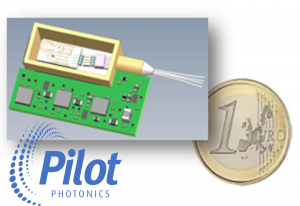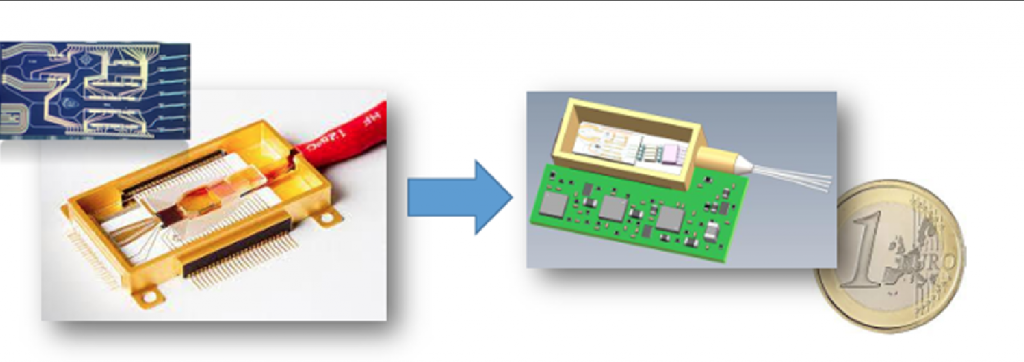Scaling coherent transceivers using integrated comb lasers

Coherent optical communication systems have traditionally met the challenge of sustained growth in traffic demand by increasing the data rate on single wavelength channels. However continually increasing baud rates has become prohibitively challenging and expensive while increasing the constellation size quickly limits the transmission reach. For these reasons, coherent channels based on multiple parallel wavelengths are emerging to facilitate continued bandwidth growth and to keep pace with ethernet optics. Today, dual-wavelength channels are implemented with individual lasers, however as channel counts increase using integrated comb lasers can offer additional benefits over individual lasers.
Integrated comb lasers deliver multiple coherent wavelengths from a single chip or package. In high capacity core networks, since all of the wavelengths are frequency locked, intra channel guard bands can be minimized or eliminated allowing capacity to be maximised. And because the wavelengths are all phase related, the DSP can be simplified, and transmission impairments can be compensated. On the other hand, in edge aggregation networks where cost and power are more critical a single comb-based terminal located at the hub can distribute fractions of the line rate as individual optical carriers to slower receivers while remaining compatible with standard optical line systems (OLS) in terms of WDM grid and routing options. Reductions in cost, size, power and complexity offered by integrated comb lasers in comparison to multiple individual lasers also make them a compelling solution for this use case.
Why Combs?
- Lower Cost – A dominant cost in any transceiver is the optical packaging which is required to protect the sensitive optical components. A comb laser approach with a single chip producing multiple wavelengths, results in fewer optical packages and therefore lower cost than an implementation based on multiple individual lasers.
- Smaller Size – Similarly, a single package delivering multiple wavelengths provides a significant footprint and volume saving, which is critical for scaling optical networks, particularly using pluggable transceivers.
- Lower Power Dissipation – Comb lasers delivering multiple wavelengths from a single chip offer the potential for reduced power dissipation due to more efficient thermal management.
- Spectral efficiency – The wavelengths produced by comb sources are fundamentally locked in frequency spacing which means that they can never drift and cause cross channel interference. This can allow spectral guard bands used in today’s networks to be minimised or eliminated.
- Controllability – Regardless of the number of wavelengths, a comb laser is defined by its central wavelength and its wavelength spacing. This can enable a simpler control strategy than managing multiple independent lasers.
- DSP simplification – Thanks to the phase coherence between the wavelengths of an optical comb full DSP is only needed on one polarization, of one sub-channel and the phase of the other channels can be inferred from this allowing the DSP to be simplified. The DSP can be simplified even further if unmodulated comb carriers can be used as pilot tones.
- Potential for non-linear impairment compensation – It has been shown that by using frequency locked wavelengths from an optical comb as opposed to individual wavelengths from independent lasers, the non-linear effects that limit the data carrying capacity of optical fiber can be largely reversed.
- Simplified network monitoring and management – Network monitoring and management is simplified because fewer transceivers are used per link.
The Challenges for comb lasers
Almost all of the highest capacity, highest spectral efficiency optical transmissions ever made have been based on comb lasers. However, these laboratory demonstrations can mask some of the challenges in using comb lasers in deployed network equipment. Chief among these challenges are
- The lack of a suitable on-chip comb laser with low linewidth and high power per wavelength suitable for integration in coherent optical communication network equipment.
- A means of separating the comb wavelengths on-chip, while retaining their coherence and sufficient power for modulation
Pilot’s Solution
Pilot Photonics’ approach solves these challenges making comb lasers suitable for coherent optical networks. In contrast to many comb laser developments, Pilot Photonics has focussed on narrow-band combs that provide a straightforward upgrade path to existing coherent transceivers.

Pilot’s on-chip comb generator is based on the patented gain switching technique which uses the direct modulation of a laser diode to generate multiple discrete wavelengths. The approach is easily integratable with other photonic components, extremely flexible and accurate because the frequency spacing is precisely tunable using an RF signal, and efficient – because the optical comb is emitted directly from the gain switched laser, without the need for an external modulator or cavity.
Having generated the comb on-chip, Pilot uses an active optical filtering technique based on injection locking which enables very fine comb line selection on-chip while maintaining phase coherence & linewidth of the comb lines. The technique provides noise free amplification of the comb lines allowing power levels comparable to integrated tunable laser assemblies to be delivered. Furthermore, the approach offers additional attractive capabilities for future transceiver development, including the ability to transmit mixed line rate sub-channels from a single laser source and coherent receiver bandwidth slicing allowing very high bandwidth channels to be received using an array of slower receivers.
Integrated Comb Laser Assembly
Pilot Photonics’ integrated comb laser assembly (iCLA) will replace four iTLA modules with a single comb-based module, delivering four, high power, low linewidth coherent wavelengths on individual waveguides. It can be delivered as a chip for integration with silicon photonic PICs or fiber coupled in a hermetic package with control PCBA.

If such a device could play a part in your coherent transceiver scaling strategy, please contact Pilot Photonics today.
[1] Gabriele Di Rosa, Frank Smyth, M. Deseada Gutierrez, Jasper Muller, Benjamin Wohlfeil, Jorg-Peter Elbers “Advancements and Applications of Comb-Based Transceivers in Coherent Optical Networks”, in Optica Advanced Photonics Congress (AP) 2023, OSA Technical Digest.
[2] Jørgensen, A.A., Kong, D., Henriksen, M.R. et al. Petabit-per-second data transmission using a chip-scale microcomb ring resonator source. Nat. Photon. 16, 798–802 (2022).